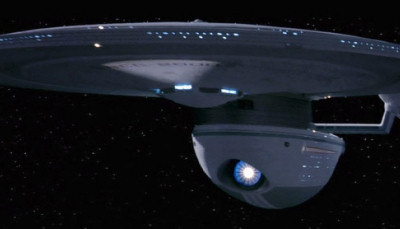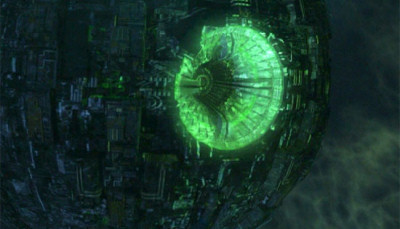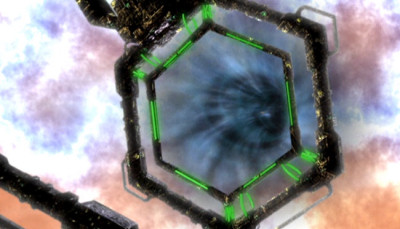
| USS Voyager in a transwarp conduit |
Chronology
Nevertheless, Federation scientists attempted to create a functional
transwarp drive system as early as 2275. Within a decade, the first
prototype was installed aboard the experimental USS Excelsior.
Unfortunately, the transwarp project ultimately proved too ambitious.
During its initial test flight in 2285, the Excelsior was nearly destroyed by
a nacelle implosion. Subsequent tests were less catastrophic, but the
Excelsior never made a successful test flight using the transwarp drive.
Starfleet abandoned the transwarp project in 2287, and refitted the
Excelsior with a standard warp drive system. (Star Trek III: The Search
for Spock).
The transwarp project remained defunct for most of the 24th century,
as many scientists came to share the opinion that a stable transwarp
drive system was unattainable. However, those preconceptions were
shattered in 2364, when the USS Enterprise-D was catapulted into
another galaxy—more than a billion light years—with assistance from an
transwarp drive system as early as 2275. Within a decade, the first
prototype was installed aboard the experimental USS Excelsior.
Unfortunately, the transwarp project ultimately proved too ambitious.
During its initial test flight in 2285, the Excelsior was nearly destroyed by
a nacelle implosion. Subsequent tests were less catastrophic, but the
Excelsior never made a successful test flight using the transwarp drive.
Starfleet abandoned the transwarp project in 2287, and refitted the
Excelsior with a standard warp drive system. (Star Trek III: The Search
for Spock).
The transwarp project remained defunct for most of the 24th century,
as many scientists came to share the opinion that a stable transwarp
drive system was unattainable. However, those preconceptions were
shattered in 2364, when the USS Enterprise-D was catapulted into
another galaxy—more than a billion light years—with assistance from an

alien being known as the Traveler. The voyage immediately rejuvenated the transwarp project as scientists began to examine the data
collected during the event. (“Where No One Has Gone Before” [TNG]). The transwarp project received another jolt in December 2369, when
the Borg invaded the Ohniaka System. The attacking was transwarp capable, able to generate transwarp conduits that extended tens of
thousands of light years. The vessel, believed to be an advanced prototype, was ultimately destroyed by the Enterprise-D. (“Descent, parts I
and II” [TNG]).
In the aftermath of the Borg incursion, the transwarp project was instilled with a considerable sense of urgency. The Borg, in demonstrating
their new vessel, also provided an influx of new information on transwarp systems. The attack confirmed the existence of a transwarp domain—
a secondary region of subspace that had been little more than theory since the transwarp project’s initiation in 2275. The Borg demonstrated
it was possible to open a conduit within the transwarp domain, effectively circumventing the standard warp barrier.
collected during the event. (“Where No One Has Gone Before” [TNG]). The transwarp project received another jolt in December 2369, when
the Borg invaded the Ohniaka System. The attacking was transwarp capable, able to generate transwarp conduits that extended tens of
thousands of light years. The vessel, believed to be an advanced prototype, was ultimately destroyed by the Enterprise-D. (“Descent, parts I
and II” [TNG]).
In the aftermath of the Borg incursion, the transwarp project was instilled with a considerable sense of urgency. The Borg, in demonstrating
their new vessel, also provided an influx of new information on transwarp systems. The attack confirmed the existence of a transwarp domain—
a secondary region of subspace that had been little more than theory since the transwarp project’s initiation in 2275. The Borg demonstrated
it was possible to open a conduit within the transwarp domain, effectively circumventing the standard warp barrier.

Unfortunately, despite the influx of new data, warp theorists around the Federation remained
unsuccessful in their efforts to create a stable transwarp drive system.
The breakthrough came in 2375, when the USS Voyager made the very first successful transwarp flight in
the Delta Quadrant. The Voyager crew had previously made several unsuccessful attempts at crossing
into transwarp (“Threshold” [VGR]), the but acquisition of a transwarp coil from a damaged Borg sphere
proved to be the critical component. Voyager was able to journey 20,000 light years in just a few
hours. (“Dark Frontier” [VGR]).
When Voyager returned to the Alpha Quadrant in December 2377, Federation scientists were eager to
inspect the coils. Combined with recent scientific advances and experiments, the transwarp project
began to move forward at an astonishing pace. The first operational transwarp drive systems were being
tested by 2387. In January 2395, the Federation officially lifted the few remaining restrictions on
transwarp flight, and a new era of space travel was at hand. (“Beginnings” [TFF]).
unsuccessful in their efforts to create a stable transwarp drive system.
The breakthrough came in 2375, when the USS Voyager made the very first successful transwarp flight in
the Delta Quadrant. The Voyager crew had previously made several unsuccessful attempts at crossing
into transwarp (“Threshold” [VGR]), the but acquisition of a transwarp coil from a damaged Borg sphere
proved to be the critical component. Voyager was able to journey 20,000 light years in just a few
hours. (“Dark Frontier” [VGR]).
When Voyager returned to the Alpha Quadrant in December 2377, Federation scientists were eager to
inspect the coils. Combined with recent scientific advances and experiments, the transwarp project
began to move forward at an astonishing pace. The first operational transwarp drive systems were being
tested by 2387. In January 2395, the Federation officially lifted the few remaining restrictions on
transwarp flight, and a new era of space travel was at hand. (“Beginnings” [TFF]).
Technology
Transwarp conduits are artificial tunnels
through the transwarp domain, often linked
together by large transwarp hubs. The
conduits are the most important part of the
transwarp infrastructure; as such, the
operation of transwarp drive systems is
fundamentally different from a standard
warp drive. Though the Federation
presently lacks the extensive network of
transwarp hubs developed by the Borg, any
starship—even one without a transwarp
drive—can gain entry into an established
transwarp conduit by emitting an encoded
tachyon pulse. Vessels traveling within
these fixed transwarp conduits typically
move at speeds thirty times faster than a
vessel traveling at warp 9. (“Descent, part
I” [TNG]).
through the transwarp domain, often linked
together by large transwarp hubs. The
conduits are the most important part of the
transwarp infrastructure; as such, the
operation of transwarp drive systems is
fundamentally different from a standard
warp drive. Though the Federation
presently lacks the extensive network of
transwarp hubs developed by the Borg, any
starship—even one without a transwarp
drive—can gain entry into an established
transwarp conduit by emitting an encoded
tachyon pulse. Vessels traveling within
these fixed transwarp conduits typically
move at speeds thirty times faster than a
vessel traveling at warp 9. (“Descent, part
I” [TNG]).
Warp Factor |
| Equals (xc) |
| Time to Travel |
| To Nearby Star (5l y) |
| Across Sector (20 ly) |
| Across Federation (8,000 ly) |
| To Andromeda (2,000,000 ly) |
| 11 |
| 32,561 |
| 1.3 hours |
| 5.4 hours |
| 89.7 days |
| 61.4 years |
| 12 |
| 47,474 |
| 55.4 minutes |
| 3.7 hours |
| 61.6 days |
| 42.1 years |
| 13 |
| 67,156 |
| 39.2 minutes |
| 2.6 hours |
| 43.5 days |
| 29.8 years |
| 14 |
| 92,588 |
| 28.4 minutes |
| 1.9 hours |
| 31.6 days |
| 21.6 years |
| 15 |
| 124,852 |
| 21.1 minutes |
| 1.4 hours |
| 23.4 days |
| 16.0 years |
| 16 |
| 165,140 |
| 15.9 minutes |
| 1.1 hours |
| 17.7 days |
| 12.1 years |
| 17 |
| 214,756 |
| 12.2 minutes |
| 49.0 minutes |
| 13.6 days |
| 9.3 years |
| 18 |
| 275,115 |
| 9.6 minutes |
| 38.2 minutes |
| 10.6 days |
| 7.3 years |
| 19 |
| 347,749 |
| 7.6 minutes |
| 30.2 minutes |
| 8.4 days |
| 5.8 years |
| 20 |
| Infinite |
| An object at warp 20 occupies all points in the universe simultaneously. |

While any vessel can gain entry into a previously established transwarp conduit, only starships equipped
with a transwarp drive system can create new conduits. The creation process yields a lower maximum
speed than a permanent or previously established conduit, however it offers the flexibility to choose an
exact route/destination rather than the predetermined course dictated by the established conduits.
Unless the aperture of the new conduit is immediately attributed to a transwarp hub, or otherwise
stabilized, the new transwarp conduit will dissipate after a few hours. (“Requiem” [TFF]).
Despite the numerous advantages of travel through the transwarp domain, it is nonetheless a highly
tenuous layer of subspace. Many regions of the transwarp domain have Cochrane values of zero,
effectively nullifying the transwarp conduits. Additionally, large portions of the transwarp network can
be easily disabled by a single torpedo. In August 2398, much of the transwarp infrastructure in the Jan’
tral Sector was destroyed when the USS Starlight collapsed a transwarp conduit established by the
Tholians to transport illicit goods into Romulan space. Scientists believe it will take the transwarp
domain several years to recover. (“Cat and Mouse” [TFF], “The Culling” [TFF]).
The Voth are the only species known to have developed a stable transwarp system that does not
access the transwarp domain. (“Distant Origin” [VGR]).
transwarp aperture.
The mouth of a transwarp conduit, where vessels enter and exit the transwarp domain.
transwarp conduit.
A narrow passageway through the transwarp domain that allows for space travel at extreme speeds.
Unless they are linked to a transwarp hub or otherwise stabilized, transwarp conduits dissipate after a
vessel passes through.
transwarp domain.
A tenuous layer of subspace with unique physical properties that allow vessels to travel in excess of
warp ten.
tranwarp hub.
A large structure erected by the Borg to maintain and connect their vast network of transwarp
conduits. As of early 2378, only five of these structures remained.
with a transwarp drive system can create new conduits. The creation process yields a lower maximum
speed than a permanent or previously established conduit, however it offers the flexibility to choose an
exact route/destination rather than the predetermined course dictated by the established conduits.
Unless the aperture of the new conduit is immediately attributed to a transwarp hub, or otherwise
stabilized, the new transwarp conduit will dissipate after a few hours. (“Requiem” [TFF]).
Despite the numerous advantages of travel through the transwarp domain, it is nonetheless a highly
tenuous layer of subspace. Many regions of the transwarp domain have Cochrane values of zero,
effectively nullifying the transwarp conduits. Additionally, large portions of the transwarp network can
be easily disabled by a single torpedo. In August 2398, much of the transwarp infrastructure in the Jan’
tral Sector was destroyed when the USS Starlight collapsed a transwarp conduit established by the
Tholians to transport illicit goods into Romulan space. Scientists believe it will take the transwarp
domain several years to recover. (“Cat and Mouse” [TFF], “The Culling” [TFF]).
The Voth are the only species known to have developed a stable transwarp system that does not
access the transwarp domain. (“Distant Origin” [VGR]).
transwarp aperture.
The mouth of a transwarp conduit, where vessels enter and exit the transwarp domain.
transwarp conduit.
A narrow passageway through the transwarp domain that allows for space travel at extreme speeds.
Unless they are linked to a transwarp hub or otherwise stabilized, transwarp conduits dissipate after a
vessel passes through.
transwarp domain.
A tenuous layer of subspace with unique physical properties that allow vessels to travel in excess of
warp ten.
tranwarp hub.
A large structure erected by the Borg to maintain and connect their vast network of transwarp
conduits. As of early 2378, only five of these structures remained.
A Borg transwarp hub

A transwarp aperture
In subspace physics, transwarp speed is any velocity greater than warp
ten. For many decades, transwarp was considered highly theoretical and
mostly unattainable under normal warp theories.
Most theories indicated that any object traveling at warp 10 would be
moving at infinite speed and, therefore, would simultaneously occupy
every point of space in the universe.
ten. For many decades, transwarp was considered highly theoretical and
mostly unattainable under normal warp theories.
Most theories indicated that any object traveling at warp 10 would be
moving at infinite speed and, therefore, would simultaneously occupy
every point of space in the universe.

Chronology
| USS Excelsior |
| transwarp |